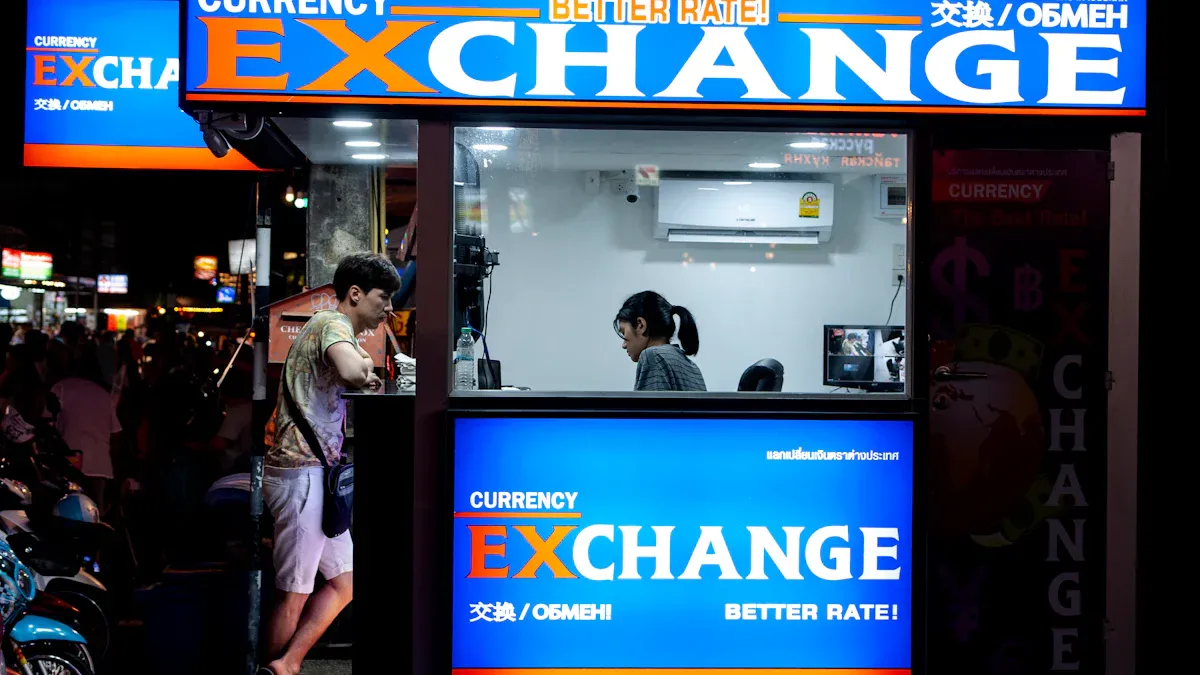- EasyCard
- Trade
- Help
- Announcement
- Academy
- SWIFT Code
- Iban Number
- Referral
- Customer Service
- Blog
- Creator
International Education Fee Payment Guide: Save on Remittance Fees and Exchange Rate Losses

Image Source: unsplash
Are you troubled by two major financial pain points when paying international education fees? One is the high transaction fees, and the other is unpredictable exchange rate losses.
Many cross-border payments incur 1% to 3% transaction fees. More importantly, small fluctuations in exchange rates can cause differences of thousands of dollars in your final expenditure. The chart below shows how exchange rate fluctuations affect the effective education costs for students from different countries.
These additional costs will silently increase your financial burden.
Key Takeaways
- Understanding education costs is important; they include tuition, insurance, living expenses, and travel fees.
- Choosing the right payment method can save money; third-party platforms are better than bank wire transfers and credit cards.
- Pay attention to exchange rate changes, exchange money when rates are favorable, or use the “lock rate” feature.
- Leverage bank promotions and policies to further reduce payment fees.
Breakdown of 2025 International Education Cost Structure

Image Source: unsplash
To effectively save expenses, you first need a clear understanding of the complete education cost structure. The total cost is far more than just the tuition figure listed on the school’s official website; it covers all aspects of studying and living.
Tuition and Miscellaneous Fees
Tuition is your largest expense. Fees vary widely across countries and schools. To give you a more intuitive understanding, here are estimated annual tuition fees for the 2025 academic year in several major study abroad destinations (converted to USD for comparison):
- United States: Public universities about $25,000 to $50,000; private universities about $30,000 to $60,000.
- United Kingdom: About $12,500 to $43,750.
- Australia: About $13,200 to $27,720.
- Canada: About $13,000 to $29,200.
In addition, you need to budget for miscellaneous fees to purchase textbooks, study supplies, and technical equipment, which can amount to around $1,300 per year.
Health Insurance and Other Mandatory Fees
Most universities require international students to purchase health insurance. Especially in the United States, school-designated insurance plans can be expensive. This cost varies based on your age, coverage scope, and study duration.
Before departure, you also need to pay some mandatory administrative fees. For example, when applying for a U.S. F-class student visa, you need to pay:
Living Expenses: Accommodation, Food, and Personal Spending
Living expenses are another important education cost. They vary by city consumption levels and your lifestyle. The table below lists estimated monthly living costs in several major study abroad cities (in USD):
| City | Estimated Monthly Living Expenses (USD) |
|---|---|
| New York (USA) | $1,700 - $3,000 |
| London (UK) | $1,500 - $1,875 |
| Sydney (Australia) | $1,190 - $1,650 |
Tip: Planning your monthly budget in advance can help you effectively control daily expenses and avoid unnecessary financial pressure.
One-Time Upfront Costs: Visa and Travel
Finally, don’t forget to include one-time startup costs in your budget. In addition to the visa-related fees mentioned earlier, you need to consider the cost of your flight to the study destination and initial expenses for purchasing daily necessities upon arrival.
Choose the Optimal Payment Method to Save on Fees
After fully understanding the cost structure, the next step is to select the most cost-effective payment method. Different payment channels vary significantly in fees, exchange rates, and processing speed. A wise choice can directly save you a considerable amount of money.
Pros and Cons of Traditional Bank Wire Transfers
Bank wire transfer (Wire Transfer) is the first option many families consider. Its advantages are reliability and acceptance by almost all schools. However, its disadvantages lie in opaque costs and numerous hidden fees.
The “handling fee” you pay at the bank counter is just the tip of the iceberg. The true cost of an international wire transfer typically includes the following components:
- Originating bank fee: The fee charged by your local bank for processing the remittance, usually between $30 and $45.
- Intermediary bank fees: When funds flow through the SWIFT network, each intermediary bank may deduct a fee. This fee is typically $10 to $30 and is deducted directly from your remittance principal, with no detailed breakdown on your statement.
- Exchange rate markup: The exchange rate provided by the bank is not the real-time market rate; it includes a 2% to 5% markup, which is the bank’s main profit source.
- Receiving bank fee: The school’s bank may also charge an incoming fee for international remittances.
Suppose you remit $10,000, and two intermediary banks each deduct $20. Even without considering exchange rate losses, the school may ultimately receive only $9,960. These hidden costs will unknowingly erode your funds.
Third-Party Payment Platforms: Flywire and Wise
To address the pain points of traditional wire transfers, many modern third-party payment platforms have emerged. They typically partner with numerous universities worldwide to provide a superior payment experience.
Flywire is the officially recommended payment platform by many overseas universities. Its biggest advantages are:
- Fee transparency: Flywire clearly lists all fees and the final credited amount before you pay.
- Better exchange rates: It offers more competitive rates than banks and can lock the rate for a period.
- Flexible payment: You can choose multiple payment methods, such as paying with a UnionPay card in mainland China via Flywire, which is convenient.
- Full tracking: You can track your payment status in real-time, like checking a package, for peace of mind.
Wise (formerly TransferWise) is renowned for its transparent fees and rates close to the mid-market rate. It is ideal for transfers to personal accounts (such as your overseas living expense account) or institutions not yet partnered with Flywire.
| Feature | Flywire | Wise |
|---|---|---|
| Transfer Speed | 1-2 business days | Same day to 1 business day |
| Main Payment Methods | Bank transfer, credit/debit card | Bank transfer, bank card |
Convenience and Cost of Credit Card Payments
Paying tuition with a credit card seems the simplest and fastest—just enter the card number to complete. But this convenience comes with a high price.
First, you must bear cross-border transaction fees. This fee typically consists of two parts:
- Card network fee: Visa or Mastercard charges about 1% processing fee.
- Issuing bank fee: Your issuing bank (e.g., a bank in Hong Kong) adds an additional 1% to 2% fee.
Second, many universities pass on costs by charging a “convenience fee” for credit card payments. This fee is usually 2.85% to 4.25% of the transaction amount.
- Purdue University Fort Wayne: Charges a 3.00% processing fee via third-party for credit card payments.
- Truman State University: Charges a 4.25% convenience fee for international credit card transactions.
- University of North Alabama: Charges a non-refundable 2.95% convenience fee.
Payment Trap Tip: When making overseas card purchases, if the merchant asks whether you want to settle in your home currency (e.g., RMB), always choose the local currency (e.g., USD). This service, known as dynamic currency conversion (DCC), typically offers unfavorable rates and increases your payment cost.
Cost-Efficiency Comparison of Payment Methods
To help you make a more intuitive decision, the table below summarizes the costs and efficiency of the three main payment methods. For large education payments, even small differences are amplified.
| Payment Method | Fee Cost | Exchange Rate Advantage | Efficiency & Convenience | Recommendation Rating |
|---|---|---|---|---|
| Traditional Bank Wire Transfer | High and opaque | Low (includes markup) | Medium, requires in-person handling | ★★☆☆☆ |
| Third-Party Payment Platform | Medium and transparent | High (close to market rate) | High, online tracking available | ★★★★★ |
| Credit Card Payment | Very high | Low (includes markup and DCC risk) | Very high, instant payment | ★☆☆☆☆ (recommended only for small emergencies) |
Overall, for large payments like tuition, third-party payment platforms are the best choice for balancing cost and efficiency.
Understand Exchange Rate Fluctuations and Seize Exchange Opportunities

Image Source: unsplash
Choosing the right payment method can save you fees, while timing your exchanges can help avoid exchange rate losses. The exchange rate market changes rapidly, and even small fluctuations are magnified in large tuition payments, directly affecting your total expenditure.
How Exchange Rates Affect Your Total Cost
Exchange rate changes directly determine how much home currency you need to convert for the required foreign currency tuition. A simple example illustrates this clearly.
Suppose you need to pay $50,000 USD in tuition.
- When the USD to RMB exchange rate is 1:7.25, you need to pay 50,000 * 7.25 = 362,500 RMB.
- If the rate changes to 1:7.35 a month later, you need to pay 50,000 * 7.35 = 367,500 RMB.
A mere 0.1 difference in the exchange rate increases your payment cost by 5,000 RMB. For multiple large payments over the study period, the potential losses from exchange rate fluctuations cannot be ignored. Therefore, learning to monitor and utilize exchange rates is a key step in saving costs.
Practical Tools for Querying and Predicting Exchange Rates
To seize favorable exchange opportunities, you need professional tools to track rates in real-time and understand market trends.
1. Real-time exchange rate tracking apps
You can download powerful mobile apps to query exchange rates anytime, anywhere. These apps typically provide real-time data, historical charts, and price alert features to help you make decisions.
| App Name | Key Features | Supported Currencies |
|---|---|---|
| Xe Currency Converter | Real-time rates, international transfers, rate alerts, analysis charts | About 130 |
| Currency Converter Plus | Smooth design, real-time and saved rates, supports cryptocurrencies | 170 |
| Easy Currency Converter | Custom currency lists, historical charts, offline mode | 200 |
| All Currency Converter | Built-in calculator, historical charts, bank rate info | 168 |
Most data in these tools comes from professional providers like Exchange Rates API, updated every minute or even every second, ensuring accurate and reliable information.
2. Professional Financial Analysis
In addition to real-time data, you can follow market analyses and forecasts from professional financial institutions. These reports provide expert insights into future exchange rate trends.
- Forex.com: Offers daily market updates and analyst research to help you understand macroeconomic factors affecting rates.
- JPMorgan Global Research: Its economic outlook reports often include forecasts for major currency pairs like USD/RMB.
By combining real-time data and professional analysis, you can more scientifically judge when the relative “low point” for exchanging currency is.
Use Rate-Locking Features to Mitigate Risk
If you’re concerned about unfavorable exchange rate movements while waiting to pay, consider using the “lock rate” feature offered by payment platforms or banks.
Rate locking, known in finance as a forward contract, allows you to lock in an exchange rate today for a future payment. For example, if you expect to pay tuition in three months, you can immediately sign a forward contract with a financial institution to fix the USD to RMB exchange rate. Regardless of market rate fluctuations in three months, you will pay at the agreed rate.
Risk and Benefit Tip: The rate-locking feature is a double-edged sword. It provides certainty and effectively avoids risks from rate increases. However, if the market rate moves favorably after locking (e.g., RMB appreciates), you cannot benefit from the better rate. Therefore, it is most suitable for users with strong risk aversion who do not want exchange rate uncertainty.
When deciding whether to lock the rate, assess your risk tolerance and judgment of future rate trends.
Leverage Policy Benefits to Uncover Hidden Discounts
In addition to choosing the right payment channel and timing, you can use policies and bank benefits to further reduce payment costs. These hidden discounts often bring unexpected savings.
Monitor Bank Cross-Border Remittance Promotions
Many banks and financial institutions regularly launch targeted remittance promotions to attract customers. You can actively follow this information to seize opportunities to save on fees.
- Bank Special Services: Some banks offer dedicated cross-border remittance services. For example, ICBC (Asia)’s “ICBC Express Remittance” service, operated via online banking, has fees as low as about $10 per transaction and waives Chinese character telex fees.
- Emerging Platform Benefits: Online platforms like Panda Remit often offer first-transfer fee waivers for new users.
- Specific Account Perks: Certain bank accounts come with international payment benefits.
| Bank/Institution | Promotion Type | Specific Benefit |
|---|---|---|
| Charles Schwab (Investor Checking) | Debit card spending | No foreign transaction fees |
| Citibank | International wire transfer | Free under specific conditions |
| Wise | International transfer | Rates close to mid-market |
Before remitting, spend a few minutes comparing the latest promotions from different banks to potentially save on fees.
Large Single Remittance vs. Batch Remittances
When paying large fees, you face a choice: remit the full amount at once or in batches? Both approaches have pros and cons.
- Large Single Remittance:
- Advantages: Simple operation, only one fixed fee. If the current rate is favorable, you can lock in the cost at once.
- Disadvantages: If the rate becomes more favorable after remittance, you miss the savings opportunity.
- Batch Remittances:
- Advantages: High flexibility. You can exchange in batches at different times based on rate fluctuations, potentially catching lower rates and averaging down overall costs.
- Disadvantages: May incur multiple fees, increasing operational complexity.
Your decision should be based on your judgment of rate trends and risk tolerance.
Compliance Declaration and Quota Management Tips
For families in mainland China, understanding and complying with foreign exchange regulations is crucial.
Per regulations, mainland Chinese residents have an annual foreign exchange purchase quota of $50,000 USD. This quota is usually sufficient for most academic year needs. If your education costs exceed this quota, you can still apply but need to provide supporting documents to the bank.
Compliance Tip: When you need to remit over $50,000 USD for tuition, banks typically require the following documents:
- Your passport and valid visa
- School admission letter
- School-issued tuition and living expense bill
Preparing these documents in advance ensures a smooth large remittance process. Compliance declaration is not only a legal requirement but also an important step in securing your funds.
Congratulations! You have now mastered the four core strategies for saving on international education payment fees:
- Fully understand the cost structure
- Smartly choose payment channels
- Scientifically time currency exchanges
- Fully utilize various benefits
Advance planning is key to saving education costs. You can, like students at Kyoshin Language Academy, choose platforms like Flywire to simplify payments; or follow the experience of Valencia College students by applying for scholarships and on-campus jobs to ease financial pressure. Only by comprehensively evaluating based on your specific situation can you ensure every penny of your education investment is well spent.
FAQ
How should I choose the payment method best suited for me?
You need to consider three factors: total cost, time requirements, and your location. For large tuition payments, third-party platforms (like Flywire) are the best choice for balancing cost and efficiency. For small emergency payments, credit cards are convenient but most expensive.
How can I minimize exchange rate losses when paying tuition?
Monitor exchange rate trends in advance and exchange when rates are relatively favorable. You can use apps like Xe to track rates. If concerned about fluctuations, consider using the “lock rate” feature on payment platforms to fix costs in advance.
What if my tuition exceeds the $50,000 USD annual quota?
You can still pay compliantly. You need to submit supporting documents to the bank to apply for remittance beyond the quota. Typically required documents include:
- School admission letter
- Tuition and living expense bill
Why is it not recommended to use credit cards for large tuition payments?
Because the costs are very high. You not only pay about 1% to 3% in cross-border transaction fees, but schools may also charge up to 4.25% in “convenience fees.” This significantly increases your total expenditure and is highly uneconomical.
*This article is provided for general information purposes and does not constitute legal, tax or other professional advice from BiyaPay or its subsidiaries and its affiliates, and it is not intended as a substitute for obtaining advice from a financial advisor or any other professional.
We make no representations, warranties or warranties, express or implied, as to the accuracy, completeness or timeliness of the contents of this publication.




Contact Us
Company and Team
BiyaPay Products
Customer Services
is a broker-dealer registered with the U.S. Securities and Exchange Commission (SEC) (No.: 802-127417), member of the Financial Industry Regulatory Authority (FINRA) (CRD: 325027), member of the Securities Investor Protection Corporation (SIPC), and regulated by FINRA and SEC.
registered with the US Financial Crimes Enforcement Network (FinCEN), as a Money Services Business (MSB), registration number: 31000218637349, and regulated by FinCEN.
registered as Financial Service Provider (FSP number: FSP1007221) in New Zealand, and is a member of the Financial Dispute Resolution Scheme, a New Zealand independent dispute resolution service provider.



















